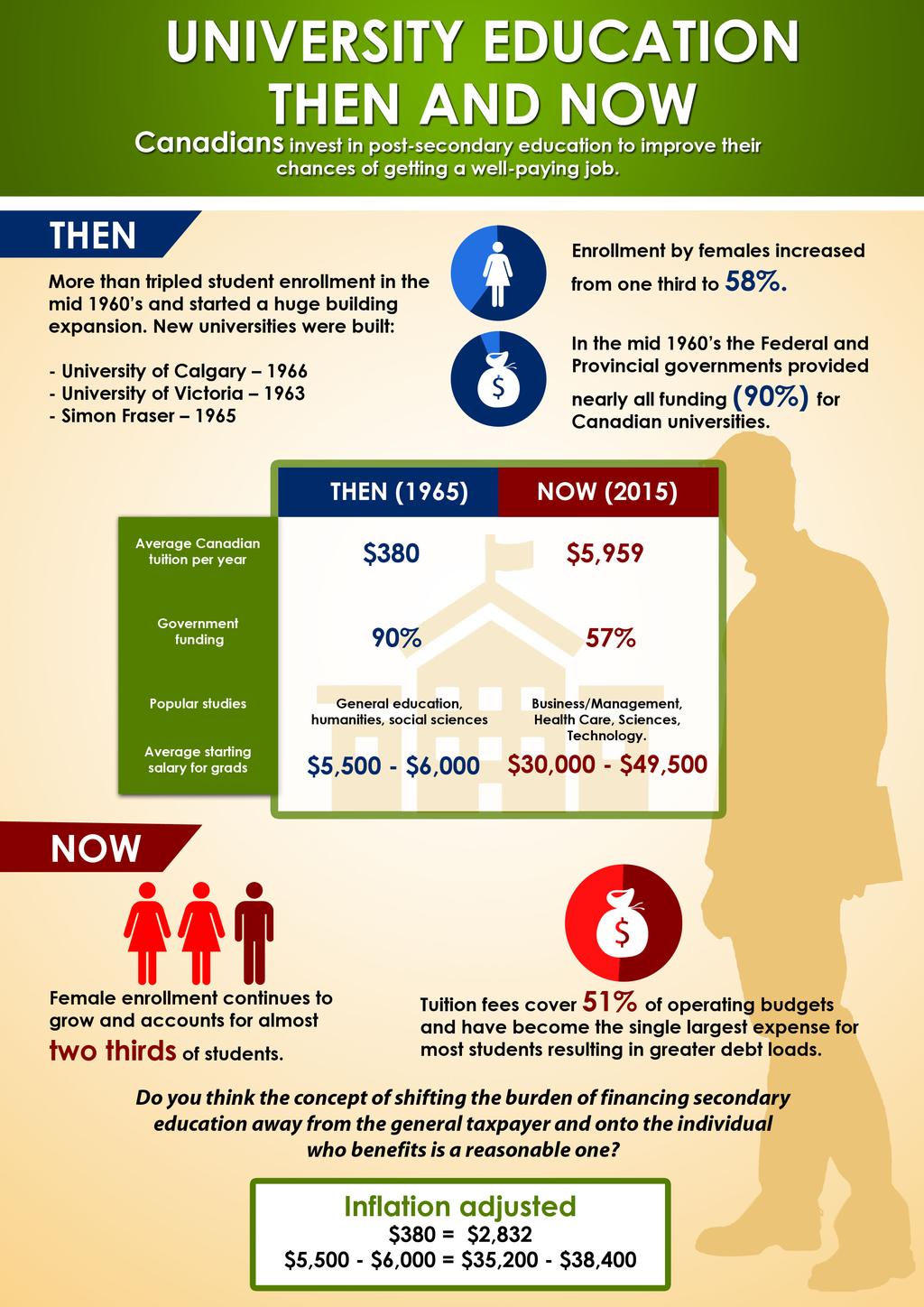Throwback Thursday: University Education in 1965 vs. 2015
Canadians invest in post-secondary education to improve their chances of getting a well-paying job.
Because of the demographic boom most Canadian universities more than tripled student enrolment in the mid 1960’s and started a huge building expansion. Older, more established universities increased faculty numbers and expanded their facilities, while new universities were built to accommodate further growth:
- University of Calgary – 1966
- University of Victoria – 1963
- Simon Fraser – 1965
This era represented a time when Canadian governments not only recognized the economic value of post-secondary education; they also invested public funds to reflect that commitment
In the mid-1960s, federal and provincial governments provided nearly all funding (90%) for Canadian universities.
Today, due to shifting educational requirements in the Canadian labour market, more employers are demanding degrees where previously a High School diploma was sufficient. University enrolment is steadily increasing and competition is stiff.
Tuition fees cover 51% of operating budgets and have become the single largest expense for most students, resulting in greater debt loads. Increases in fees were the direct result of cuts to public funding by both federal and provincial budgets.
Do you think the concept of shifting the burden of financing secondary education away from the general taxpayer and onto the individual who benefits is a reasonable one?


Inflation adjusted figures — appears as if they adjusted both the past and present figures. Shouldn’t comparison be between the past adjusted figure to the actual present figure?
Hi Brian, the way I read it – $380 in 1965 should be $2,832 in today’s dollars (adjusted for inflation). So with tuition at $5,959 today, you can see that it has grown much faster than inflation.
The second figure is the starting salaries: a $5,500 starting salary in 1965 should roughly be worth $35,200 in today’s dollars. So at the lower end, the starting wages are not keeping up with inflation. The top end, however, has surpassed the inflation-adjusted wages of 1965.
Maybe I have been wrongly informed,but from what I have heard, some countries pay for all the education of the students. One example, that I know of, is CUBA.
I think Canada has enough money to pay for Education. Well, at least maybe a compromise that 75% be paid by the country and the remainder by the students. More and more students come out of university with a diploma, but cannot find jobs in their field. So that is discouraging for future students. Either more jobs be created or limit how many students be allowed to study. Create more permanent jobs and stop the part-time jobs. That way, less students would want to go to University. I was lucky, when I graduated from high school, I went to work in the government and worked for 35 years. I did not have a university education, and had this great job. I studied at night and so did many of my colleagues. Public service jobs are secure, and education is not a prerequisite for the clerical jobs. Then one can study evennings without getting into debt. Just saying. FREE EDUCATION IS NEEDED OR HAVE MORE PUBLIC SERVICE JOBS .
I wouldn’t recommend Cuba as a great example. Yes, the education is free, but a doctor and lawyer (both government paid) is paid the same as jobs with much less education (taxi driver, waiter, except they both get tips!). I’ve had a lawyer as a taxi driver in Cuba.
I do agree with companies helping to pay for education part time. Even Tim Hortons and McDonalds are offering to pay some tuition, as well as a lot of larger private companies.
I don’t necessarily agree with the government paying too much more for education. It would mean higher taxes to be paid by all. And the government cannot be the main go to for jobs. We cannot all rely on the government for jobs in this (or any) country.
Well, first let me distance myself from Daisy’s remarks about Cuba. It is a disaster and a failed nation from almost any vantage point, and certainly contributes nothing to the world academically.
However, when it comes to education I would fully support it being almost entirely funded by the public. This would require some controls. However, the future of the country should not be affected by one’s ability to pay for education. This is true for all forms of further education, not just universities.
On a lighter note, I wish I was 18 again. I like that ratio of women to men.
Hey, when you’re 65+ there are a LOT more women than men out there….
With MOOCs, education in and of itself is free.
The little piece of paper with your name on it, is not.
Unfortunately, that little piece of paper is what people recognize.
It would be interesting to know what’s included in the government funding portion. For example, are the following included:
-RESP benefits
-Tuition and education tax credits
-Tax credits for donations to universities
-Scholarships and reduced interest rate loans provided by governments
?
I suspect these are not included, yet they effectively shift tuition costs away from students and towards taxpayers.
@J – I think that figure is specifically referring to operating grants, which does not include any capital projects, research, or other direct student support the province provides through grants and scholarships.
I think the individual should pay. So many university degrees are never used and it is no loss for the student because the government and their parents paid for it. Many employers want to see a university degree when the job can just as easily be done by someone without a degree. If a person really wants a degree they will find a way to pay for it. Why not work along the way and take a few more years to get the degree – no harm in that.